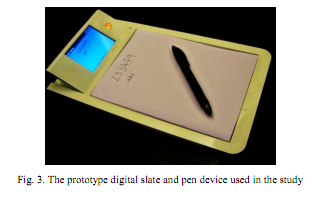A low-tech Microsoft slate for the masses

You can never be too thin or too fast ... or too pricey -- if you're a slate/tablet targeted at the developed world. But if customers in the developing world are your focus, iPads, Galaxy Tabs and Windows 7 business slates are probably out of the reach of most of them.

For the past year-plus, Microsoft researchers have been testing a digital slate that combines old fashioned paper with a newer-fangled digital stylus and Windows CE-based computer. Microsoft tested the device among a couple of hundred rural Indian microfinance customers and detailed the findings in a white paper entitled "Managing Microfinance with Paper, Pen and Digital Slate." (The paper was last revised in July 2010.)
The researchers call the device they tested a "low-cost digital record management system." It uses "handwritten pen and inkbased input on ordinary paper forms to directly manipulate a local digital database and allow real-time digital processing and feedback in the absence of a conventional computer."
The Microsoft researchers said they considered a number of input alternatives when designing the low-tech slates, including handwritten pen/paper with digital pens; stylus, keypad, keyboard input; and voice input. They went with an existing third-party handheld digital slate and pen prototype that was prototyped as a note-taking PC for the education market.
Here's more from the paper on the device itself:
"The slate has an A-5 size (210mm X 145mm) digitizing pad on which ordinary paper or a book can be placed, and anything written on the paper using the device‘s digital ballpoint pen is simultaneously digitally captured as raw strokes. The device also has a 3.5-inch touch screen display and runs on Windows CE. The back of the device‘s pen, fitted with the pen cap, serves as a stylus for touch screen input.
"The device has a memory of 512 MB and an inbuilt SD card reader that allows expandable storage as required. The slate has an audio-out port. It runs on rechargeable batteries with a battery life of 5-7 hours after a full charge. The active pen runs on a single AAAA battery."
While there are "no immediate commercialization plans" for the low-tech slate, the researchers estimated that a single unit witht he digital slate and pen could cost about $100 (U.S.) if/when mass-manufactured.
"Every handwritten digit on the paper generated a 29X29 bitmap image that was recognised and displayed on the touch screen within one second of a pen stroke being completed," the researchers said.
I have no idea what Microsoft's intentions are regarding this device/market, but still thought it worth noting that there's room -- and need -- for lots of different kinds of slates and tablets, at lots of different price points. Microsoft seems to still consider the stylus/pen as worth supporting in slate/tablet designs (as do a lot of you readers). I wonder how many of the coming Windows 8 slates will provide pen-input, alongside multi-touch....